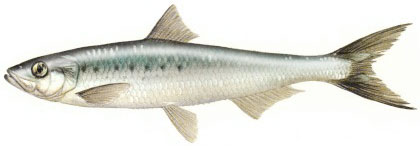Pacific Sardine

Scientific Classification
Sardinops sagaxPhysical CharacteristicsClass: Clupeiformes
Family: Clupeidae
Some sardines mature at 18 cm (7 in), most are mature by 24 cm (9.5 in). They can reach 16 inches, but are usually less than 12 in. There is a good deal of regional variation in growth rates, with average size increasing from south to north. In the Pacific northwest, sardine will reach 215 mm after four year and 235 mm after five years. Females will grow faster than males. Some individuals mature in their first year, most in their second. Maximum age 13-25 years, most are less than 8 years. Size and age at maturity may decline with decrease in biomass.HabitatThe Pacific sardine is a pelagic fish found in the eastern Pacific from southeast Alaska to Baja California and the Gulf of California and also along Peru and Chile. They form large schools (up to 10 million individuals) and are often associated with anchovy, hake, and mackerel.DietSardines are filter feeders, preying on plankton (chiefly small crustaceans such as copepods) and other plankton. All sizes of sardines are food for a large variety of marine birds, fishes, and mammals. Sardines may become more important as prey for many species as the sardine resource continues to increase.BehaviorsThe Pacific Sardines migrate up and down the Pacific Ocean. The northern sub-population of sardine has made extensive migration, moving north to British Columbia in early summer and back to southern California in the fall and winter. Each year of life, the migration is farther to the north. The largest oldest fish as the culmination of the northward movement reach the west coast of British Columbia, with somewhat small sizes off Washington and Oregon. The timing and extent of migration is affected by oceanographic conditions. The extent of the migration is not as great with smaller population sizes.ReproductionMain spawning areas are off southern California, in the upper 165 feet of the water column, out to about 100 miles. Sporadic occurrences have occurred off British Columbia and Oregon. The spatial and temporal distribution of spawning is influenced by temperature. During warm water conditions, the center of spawning has shifted northward and continued longer. Spawning mostly occurs at temperatures between 59° and 65° F. Some spawning may occur year-round, but it peaks in April to May and usually occurs at night. Sardines will spawn several times over a season with a large female producing up to 200,000 eggs in a season. Eggs are found near the surface and will hatch in about three days. Young fish move inshore and congregate into schools near the beach.
Back